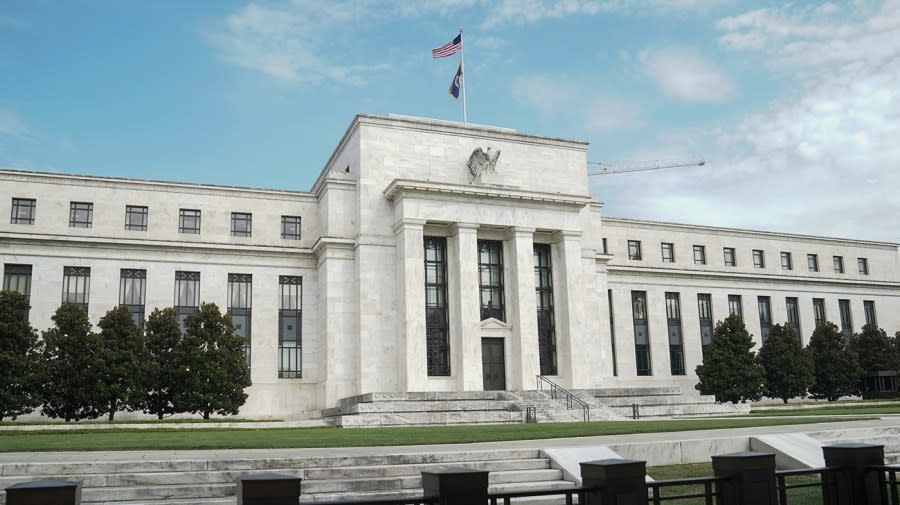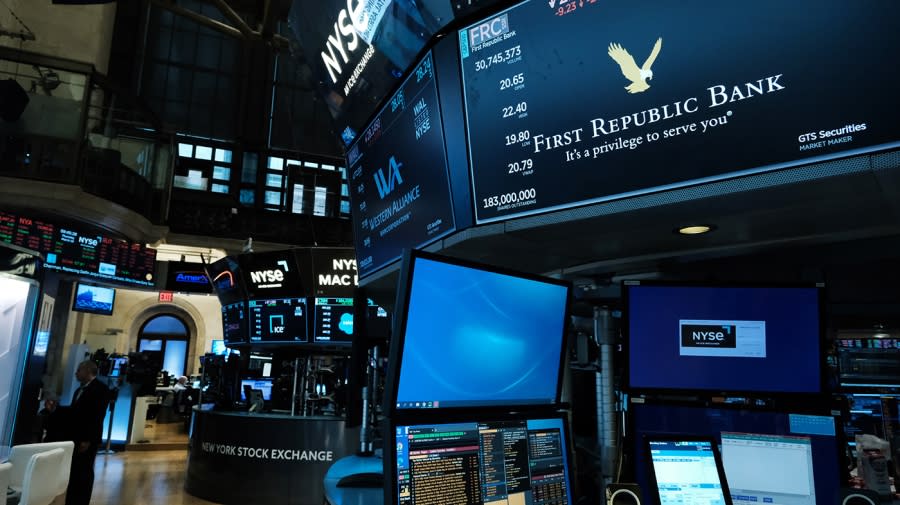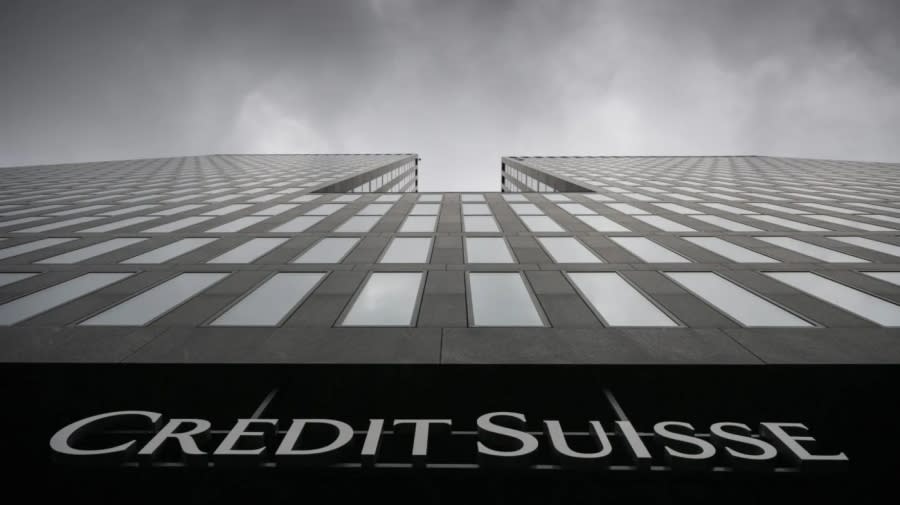How the banking crisis throws a wrench into Fed rate-hiking
Some bankers and analysts think the Federal Reserve may take a break from its rate hikes after the failures of several banks in the U.S. and Europe.
The Federal Open Market Committee (FOMC), the Fed’s rate-setting panel, is set to meet Tuesday and Wednesday before announcing whether it will go ahead with another rate hike, which had been seen as nearly inevitable only a week ago.
The view from Wall Street: Goldman Sachs expects pause in Fed’s interest rate hikes
Two months of strong jobs growth and stubbornly high inflation seemed to keep the Fed on track to raise rates by 0.25 percentage points Wednesday. But the shotgun sale of Credit Suisse over the weekend to Swiss rival UBS — along with extraordinary measures to salvage First Republic, Silicon Valley Bank and Signature Bank in the U.S. over the last week — are causing analysts to reconsider.
Interest rate prediction algorithm FedWatch by financial company CME put the odds that the Fed wouldn’t hike rates at all at 31.4 percent on Monday afternoon, as stock markets rallied.
That option wasn’t even on the table after the January personal consumption expenditures (PCE) price index ticked up to an annual increase 5.4 percent earlier this month.
“We expect the FOMC to pause at its March meeting this week because of stress in the banking system,” Goldman Sachs analyst Jan Hatzius and others wrote in a Monday note to investors.
“While policymakers have responded aggressively to shore up the financial system, markets appear to be less than fully convinced that efforts to support small and midsize banks will prove sufficient. We think Fed officials will therefore share our view that stress in the banking system remains the most immediate concern for now,” they wrote.
The analysts added that they believed “the inflation fight can wait six weeks” until the FOMC’s next meeting at the beginning of May.
Big names are telling the Fed to chill out

Fed officials have justified their rate hikes primarily in terms of inflation and the alignment of supply and demand, leaving questions of stability in the financial sector largely aside.
A number of influential market commentators wondered Monday whether the Fed should take a break from its rate hikes until the banking sector settles down.
Get up to speed: What you need to know about this week’s banking crisis
“Don’t just do something: sit there,” economist Paul Krugman wrote online Monday morning, adding that the current financial instability was “good reason to pause and wait for more information, unless you’re deeply worried about Fed credibility.”
“The banking mess is, as far as I can tell, sufficient reason for the Fed to pause until we know more,” he wrote.
Progressive economists find an unlikely bedfellow in Wall Street

This newfound dovishness is putting the financial sector in line with more progressive voices in the economy. Left-leaning economists and analysts have spoken against rate hikes not because of the liquidity pressures they were putting on banks, but because of the damage they would wreak on the labor market.
What comes next: Biden urges Congress to crack down on failed bank executives
“Inflation is coming down in spite of the Federal Reserve’s callous rate hiking campaign, not because of it. It’s clear that we do not need to create mass joblessness to bring down prices,” said Rakeen Mabud, chief economist of the Groundwork Collaborative, a progressive research nonprofit, in a statement earlier this month.
“If the Fed doesn’t pause rate increases, millions of people will lose their jobs. It’s time for Chair Powell to stop gambling with people’s lives.”
Quantitative tightening may be stalling
Even if the Fed takes a break from rate hikes, its program of quantitative tightening may be coming to an effective end anyway.
Total assets held on the Fed’s balance sheet spiked from $8.34 trillion to $8.64 trillion over the course of last week, indicating the bank likely shelled out around $300 billion in loans and asset purchases to banks concerned about their liquidity.
Roughly $143 billion of the new lending was through two bridge loans to the bridge banks created to replace Silicon Valley Bank and Signature Bank, according to an analysis from Deutsche Bank.
SVB latest: SVB parent company files for bankruptcy after bank collapse
Banks borrowed another $153 billion from the Fed’s primary credit discount window, which exists to handle short-term cash shortages, and $12 billion through the Bank Term Lending Program, the emergency facility set up to protect deposits across the banking system.
The spike in borrowing comes after the Fed had spent the last year shrinking its balance sheet by selling off bonds it purchased to stimulate the economy during the depths of the pandemic. That move complements its interest rate hikes, which are intended to make borrowing more expensive and slow economic activity.
Gregory Daco, chief economist at audit firm EY, said the Fed will likely keep allowing some bonds on its balance sheet to expire as planned to show markets it can fight inflation while also keeping the financial system stable.
“This may sound at odds with the near $300bn increases in the size of the Fed’s balance sheet in the past week. But it ties back into the Fed’s likely desire to distinguish its monetary policy tools from its financial stability tools,” Daco wrote in a research note.
Daco said he thinks the Fed will hike interest rates by 25 basis points, but shouldn’t.
The $300 billion in new loans wipes out nearly half of the quantitative tightening the Fed had executed since March of last year, when it began raising rates.
The question is how much of that money actually makes its way into the economy in the form of new loans to businesses and households, which can act as stimulus and add to inflation, and how much is simply being used to prevent bank runs and make sure people can keep withdrawing their funds.
The Europeans are staying the course on rate hikes

Despite the collapse of one of Europe’s largest banks in Credit Suisse, the European Central Bank (ECB) charged right ahead with its own program of quantitative tightening last week, hiking rates last week by 0.5 percentage points. That’s double what the Fed was expected to do later this week.
For the ECB, the fight against inflation, which is worse in many countries in Europe than in the U.S., is taking precedence over troubles in the banking sector.
Shotgun wedding: UBS agrees to buy banking rival Credit Suisse in emergency rescue
Annual inflation rates in February were 6.3 percent in France, 8.7 percent in Germany, 8.8 percent in the United Kingdom and 9.2 percent in countries across the Organization for Economic Cooperation and Development (OECD), according to OECD data. That’s compared to 6 percent in the U.S.
“Inflation is projected to remain too high for too long. Therefore, the Governing Council today decided to increase the three key ECB interest rates by 50 basis points, in line with its determination to ensure the timely return of inflation to the 2 percent medium-term target,” the ECB said in a statement last Thursday.
European Central Bankers added that they were “monitoring current market tensions closely and [stand] ready to respond as necessary to preserve price stability and financial stability in the euro area.”
“The euro area banking sector is resilient, with strong capital and liquidity positions,” they said.
For the latest news, weather, sports, and streaming video, head to The Hill.

